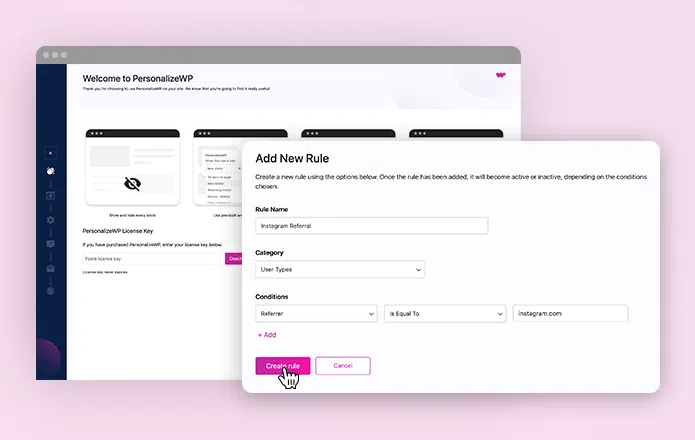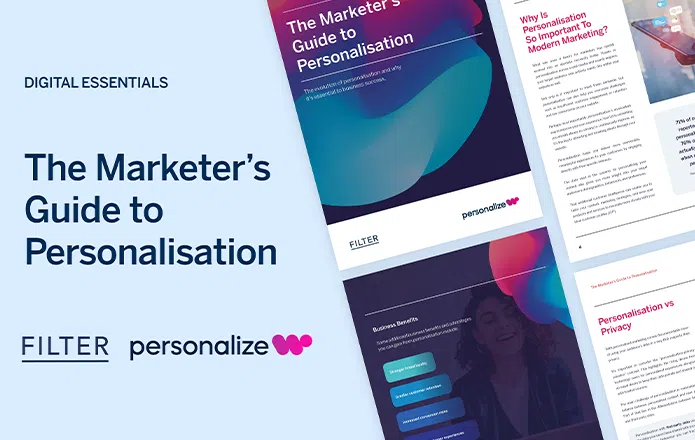
This article will give you a detailed understanding of personalisation so you can begin taking advantage of the opportunities and benefits for your own business.

Table of contents
Personalisation has become a vital tool for marketers in the travel, tourism, and hospitality industries, but many are still missing out on the best ways to implement it across their websites.
This article will give you a detailed understanding of personalisation so you can begin taking advantage of the opportunities and benefits for your own business.
Recent technology trends have significantly changed how consumers want to access and interact with brands in the travel, tourism, and hospitality industries.
With so much business shifting to a digital-first context, and your buyers’ journey becoming increasingly complex, providing an outstanding online customer experience has never been more important.
We all know that most consumers today will do plenty of research into multiple brands, products, and services online before buying anything. They also want to book things like flights, hotels, experiences, and restaurants online without ever speaking to a member of your team.
Those stages of browsing and researching online are a great opportunity to be taken advantage of by capturing your audience’s attention and drawing them into your website.
However, with so much bite-sized content consumed every day on platforms like Instagram and LinkedIn, your audience’s attention span has also decreased radically as well. This has given you even more difficulty when trying to stand out from the crowd and retain their interest.
Thankfully, these challenges can be eased, and solved, by harnessing the potential of a particular method of marketing that has risen to prominence over the last few years.

This article will help you gain a better understanding of personalisation, and will provide you with guidance to begin building better relationships with your customers and wider target audiences online.
These trends – among others – have made it essential for all businesses to provide customers with personalised content, services, and user experiences (UX) online, tailored specifically to each individual’s preferences.
Of course, this is nothing new. We’re all familiar with having our search engine results, social media content, and online ads shown to us specifically because of things we’ve clicked or searched for in the past.
It’s clear then that personalisation in the travel, tourism, and hospitality industries has become less of a “nice-to-have” and more of a necessity these days. And, like most businesses, you’re likely already providing some level of personalised interactions to your target audience.
But there’s a great deal of untapped potential here that can deliver significant advantages when done strategically. So, let’s take a closer look at how personalisation works and how you can leverage it to attract more customers.
98% of marketers reportedly believe that personalisation advances customer relationships.
Any time a visitor lands on your website, you should be aiming to provide them with a UX directly aligned with their specific needs or interests. Personalisation can help them achieve their goal in as few steps as possible, and it can give them what they’re looking for before they even ask for it.
On your website, this could include everything from dynamic content, recommendations and suggestions, pop-up messages, and special offers and discounts.
For example, if you’re a travel company, a customer could visit your site to book a flight. While they’re booking their flights, relevant recommendations for hotels in that city can be presented to them with discounted prices. You could tailor these hotel recommendations even more by accompanying them with special offers for experiences or perks relevant to that customer’s interests.
Not only does this guide them towards completing the purchasing process with effective personalised marketing, it also demonstrates that your brand understands their interests, which in turn builds a lasting connection.
Once that customer has secured their booking, you can then present them with additional offers relevant to them, based on the pages they’ve visited previously on your site.
Some other ways you can use personalisation specifically in the context of the travel, tourism, and hospitality industries include:

Personalisation is now an essential part of any marketing strategy and there is an easy solution for WordPress websites. PersonalizeWP is a no-code WordPress plugin that helps you deliver targeted content to the right people, in the right place and at the right time.
Many marketers in the travel, tourism, and hospitality industries believe they’re limited in their capabilities with personalisation, because of a common misconception that it requires a large-scale investment in an enterprise system like a digital experience platform (DXP).
Of course, many marketing budgets simply aren’t large enough to make that kind of investment. In the current climate, your business may even be discussing cuts in spending for marketing.
However, most marketers are also unaware that free, open-source content management systems (CMS) can also deliver personalisation to great effect. It’s not always necessary to use an expensive, complex DXP, or invest in a dedicated customer data platform (CDP) just to personalise your audience’s experiences.
Leveraging a traditional, more cost-efficient CMS, such as WordPress, is an intelligent way to keep costs minimised, while still gaining all the same personalisation capabilities as more robust platforms.
This can be done in a number of flexible ways:
Sticking with WordPress as an example – since it’s the world’s most popular CMS by some distance – you can use the platform to easily create highly targeted experiences for your website visitors.
Free plugins for open-source platforms such as PersonalizeWP can provide a wide range of functionality and use cases for businesses in the travel, tourism, and hospitality industries.
You can also leverage WordPress’s seamless integration with other third-party systems to unlock a wealth of possibilities for greater personalisation. An integration with HubSpot, for example, will allow you to pull data from that database into your CMS to add deeper levels of personalisation for all those visitors.
You could also use custom API integrations, or even develop certain features bespoke within the platform, to enable personalisation in your CMS. Because WordPress is particularly easy to work with, these things can still be delivered for you at a reasonable cost and a fast time-to-market.
This gives you an easier, more cost-effective solution to advanced personalisation than adopting a heavy-duty digital experience platform (DXP).

Introducing our new eBook, part of the Filter team’s Enterprise Series. This edition explores the power of Personalisation, guiding businesses on delivering tailored content to website visitors based on their interactions and browsing history.
Personalisation comes with an unavoidable challenge of using your audience’s data in a way that respects their privacy. While your visitors do want personalised experiences, they also have an equal desire to keep their data private and shared only with trusted sources.
This means you need to find the right balance between first-party and third-party data.
Personalisation with first-party data uses only the data your users have shared with you directly, as well as the behaviour you can track across your own channels.
Personalisation with third-party data uses data about your website visitors that is gathered from other sources, which you can then use to tailor your content to them.
Third-party data has been commonly used by many businesses in recent years to make their targeting as specific as possible. However, this is becoming increasingly frowned upon, and the trend of using only first-party data to implement personalisation is emerging as the preferred approach. This is a complex topic, and you can gain a full understanding of the issues by clicking here.
For now, it’s worth noting that the more you can do to build your relationship with your target audience through your own platform, without using third-party data, the better.
You’ve likely seen hundreds of posts on social media recently about generative artificial intelligence (AI) tools like ChatGPT.
One highly valuable use case of AI technology for marketers is in transforming your personalisation capabilities.
You can use AI-powered tools to analyse your target audience’s behaviour, preferences, data, and browsing habits. AI can continuously learn from every single user interaction, gathering data and providing you with unprecedented insights into your target audience.
All this can be done without any manual effort from you or your team, saving you enormous amounts of time and allowing you to focus your efforts more on higher value strategic work.
If you can become a forward-thinking, early adopter of AI tools, you’ll gain a wealth of advantages over your competitors in this area.
Successfully implementing personalisation on your website will deliver a great deal of other benefits as well.
Personalisation will make your website more engaging and effective, guiding each of your visitors more directly towards purchasing your products or services. This greatly improves the UX of your website, which is something you should always be striving to do on a continuous basis.
Personalisation helps you deliver more memorable, meaningful experiences to your customers by engaging directly with their specific interests. That will in-turn allow you to:
As well as improving your UX, the customer data that you collect when implementing personalisation can also be used to your advantage in another way. It gives you unique insights into your website visitors’ demographics, behaviours, and preferences. That deeper level of understanding about your visitors will help you to raise the quality of your content, make your marketing strategies more targeted, and potentially even help your products and services resonate more closely with your customers.
To help you truly master personalisation, we’ve recently published The Marketer’s Guide to Personalisation: How to Make Personalised Marketing Simple and Effective on Any Platform.
This eBook serves as an in-depth guide to personalisation that will guide you towards selecting the best approach, help you overcome challenges with data privacy, and offer plenty of advice to make your own personalisation strategy successful.
This eBook also includes:
Overall, in today’s digital landscape, personalised marketing has become an essential for businesses, especially within the travel, tourism and hospitality industries.
In this article we have highlighted the significance of delivering outstanding online customer experiences and explored the power of personalisation in modern marketing. There are various cost-efficient solutions and implementation doesn’t have to be a convoluted process.
Personalisation has many benefits such as enhanced customer experiences, increased conversion rates and gaining a competitive advantage.
Make sure to get in touch with our team to discuss how personalisation could factor into your next digital project.